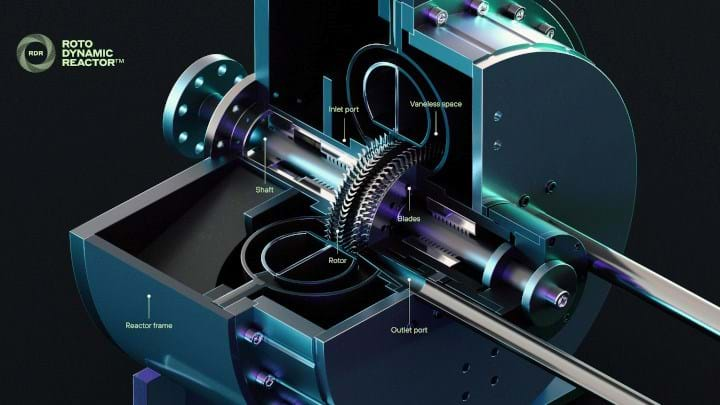Coolbrook primed for industry use after RotoDynamic Heater pilot tests reach over 1,000°C

COOLBROOK has successfully completed the first phase of largescale pilot testing for its RotoDynamic Heater which demonstrated its capabilities for industrial use in high-temperature process heating. This will enable the technology to move forward to industrial scale projects at customer sites, the firm said.
Coolbrook’s RotoDynamic Technology comprises of the RotoDynamic Heater (RDH), and the RotoDynamic Reactor (RDR). Both technologies are based on a rapidly rotating shaft connected to a series of rotor blades, similar to those used in a gas turbine. But instead of a hot gas turning a turbine to produce electricity, it works in reverse, and an electrical motor turns a blade to generate a hot gas.
As the blades rotate, the gas in the reactor, which can be anything from air, nitrogen, carbon dioxide, hydrogen, or another gas, is mixed and accelerated to very high velocities, before being slowed down in a diffuser. Heating of the gas is produced in two ways; by friction from the intense turbulence, and via a shockwave from the rapid acceleration of the gas to supersonic velocities, followed by a deceleration to subsonic velocities.
In the RDH, the heated gas is then used outside the heater to replace the burning of fossil fuels in process heating. The RDR, in contrast, is best suited for CO2-free steam cracking in petrochemical processes.
The now completed test phase, which took place at the Brightlands Chemelot Campus in the Netherlands, saw the RDH reach 1,000°C, a temperature that already exceeds the range of conventional resistive heaters by several hundred degrees. However, the tests also showed that the RHR is capable of reaching up to 1,700°C. This covers more than 95% of the temperature range required to cover the €1trn (US$1.1trn) industrial heating market, the firm said.
According to Coolbrook, its RDH can be retrofit to existing industrial facilities, has zero CO2, nitric oxide, and sulfur oxide emissions, and has the potential to reduce global CO2 emissions by over 2bn t/y.
Electrifying the cracking process
The next test phase will encompass the demonstration of Coolbrook’s RHR technology, which the firm developed through collaborations with the universities of Oxford, Cambridge and Ghent, Neste Engineering, and Mitsubishi Heavy Industries.
Coolbrook describes its RHR as “the only technology in the world” capable of eliminating 100% of the CO2 emissions created in the steam cracking process.
Steam crackers play a central role in the production of high-value light olefins such as ethylene and aromatics – compounds that are used primarily in the production of plastics.
They work by first mixing long chained hydrocarbons with steam, then running the mixture through tubes in a cracking furnace. However, the heat needed to induce the reactions inside the tube is applied from outside of the tube walls using non-renewable fossil fuels and massive amounts of energy.
Instead of heating the feedstock mixture from outside the reaction zone, the RDR’s high-velocity rotor blades create thermal energy to heat the mixture inside the tube in the reaction zone, quickly and much more efficiently, the firm said.
Figures suggest that the steam cracking industry is responsible for the consumption of around 110m t/y of natural gas, which is equivalent to about 4% of global natural gas consumption from all sectors. This leads to a staggering release of about 300m t/y of CO2 that accounts for 30% of global emissions from the chemical and petrochemical industries.
Because the RDR uses renewable electric power, it makes it the only technology capable of cutting 100% of direct process emissions, Coolbrook said, and as it creates higher temperatures with a shorter residence time, it is able to achieve 20% higher ethylene yields. For petrochemical producers, this will increase annual profits for a 1m t/y ethylene plant by more than US$200m.
Ilpo Kuokkanen, the firm’s executive chairman, said: “Coolbrook has set out to build a committed and comprehensive ecosystem around RDR and RDH technology to commercialise it as soon as possible. Together with our partners in industry, academia, the public sector, and key decision-makers, we can roll out this revolutionary technology and achieve significant emission reductions in the most energy and CO2 intensive industrial processes, which until now have been considered impossible to electrify.”
Recent Editions
Catch up on the latest news, views and jobs from The Chemical Engineer. Below are the four latest issues. View a wider selection of the archive from within the Magazine section of this site.




